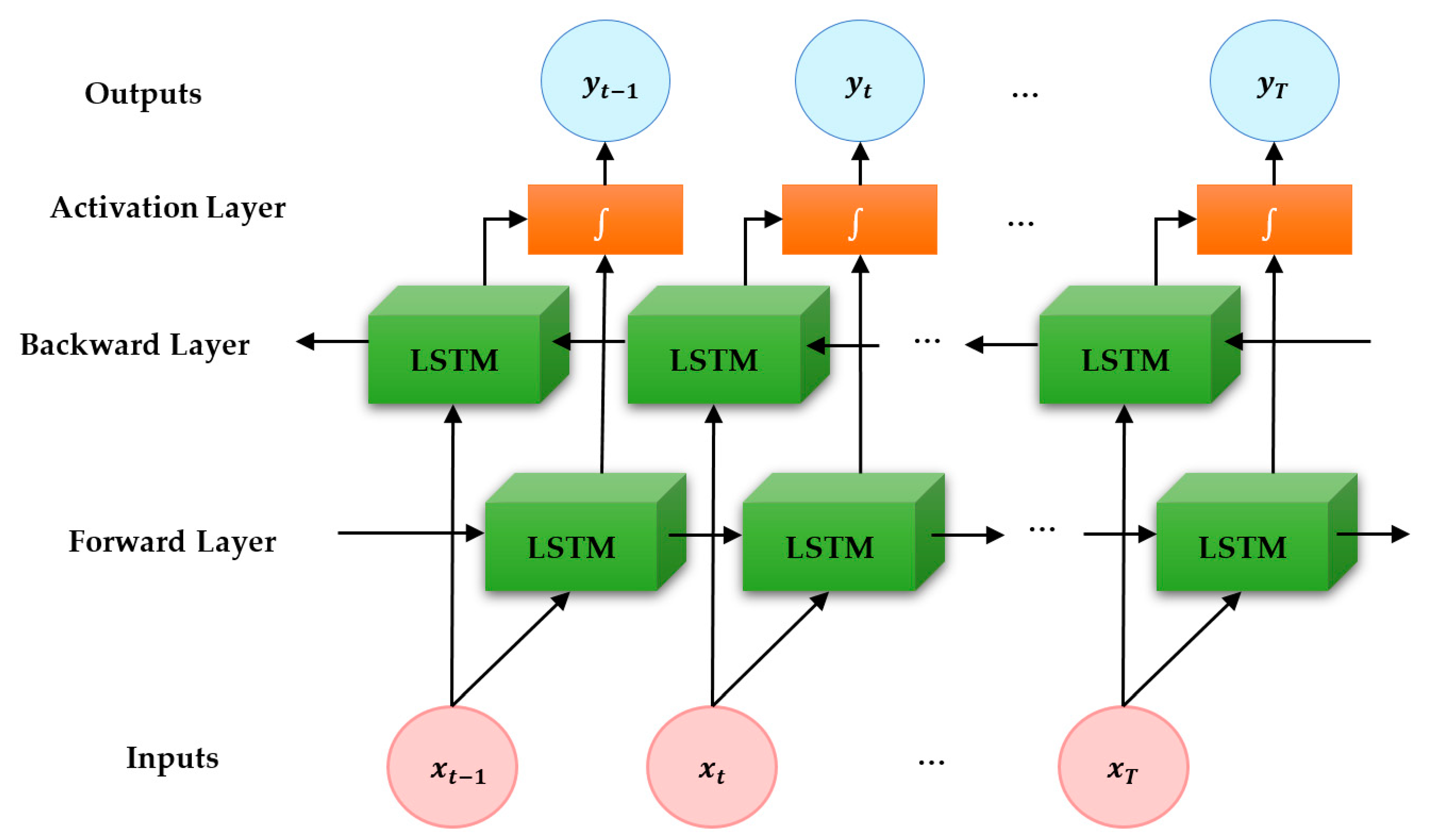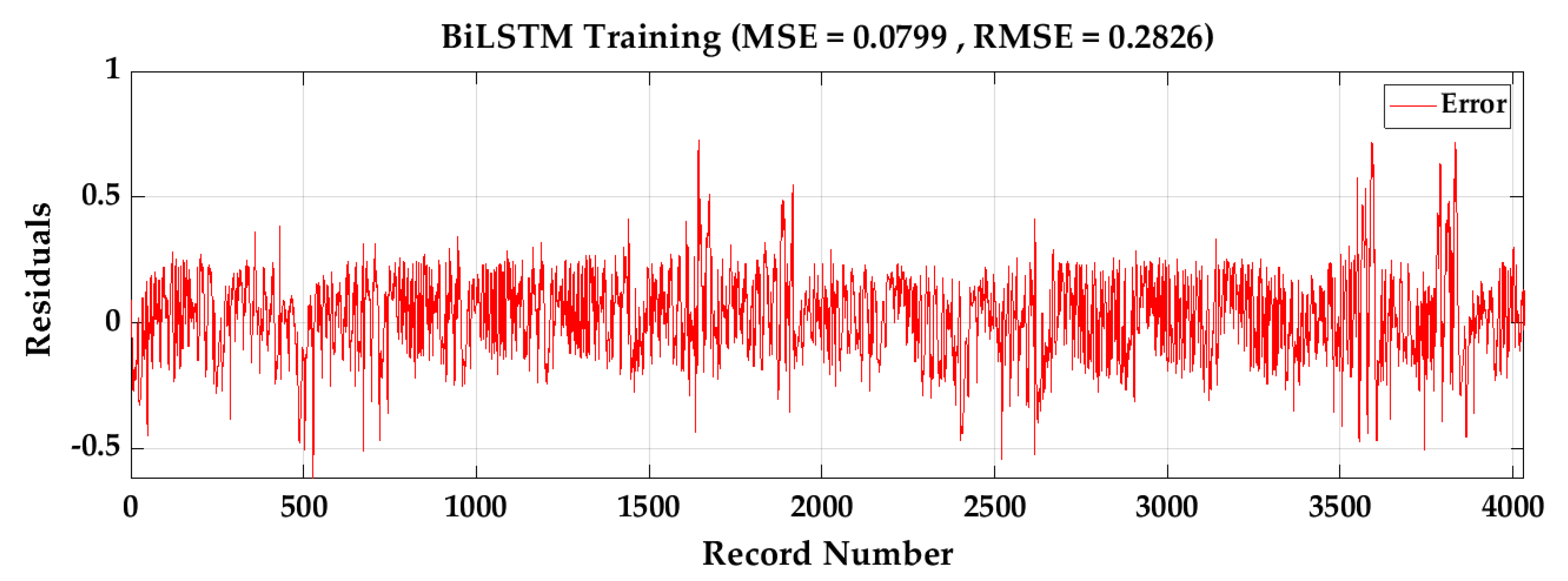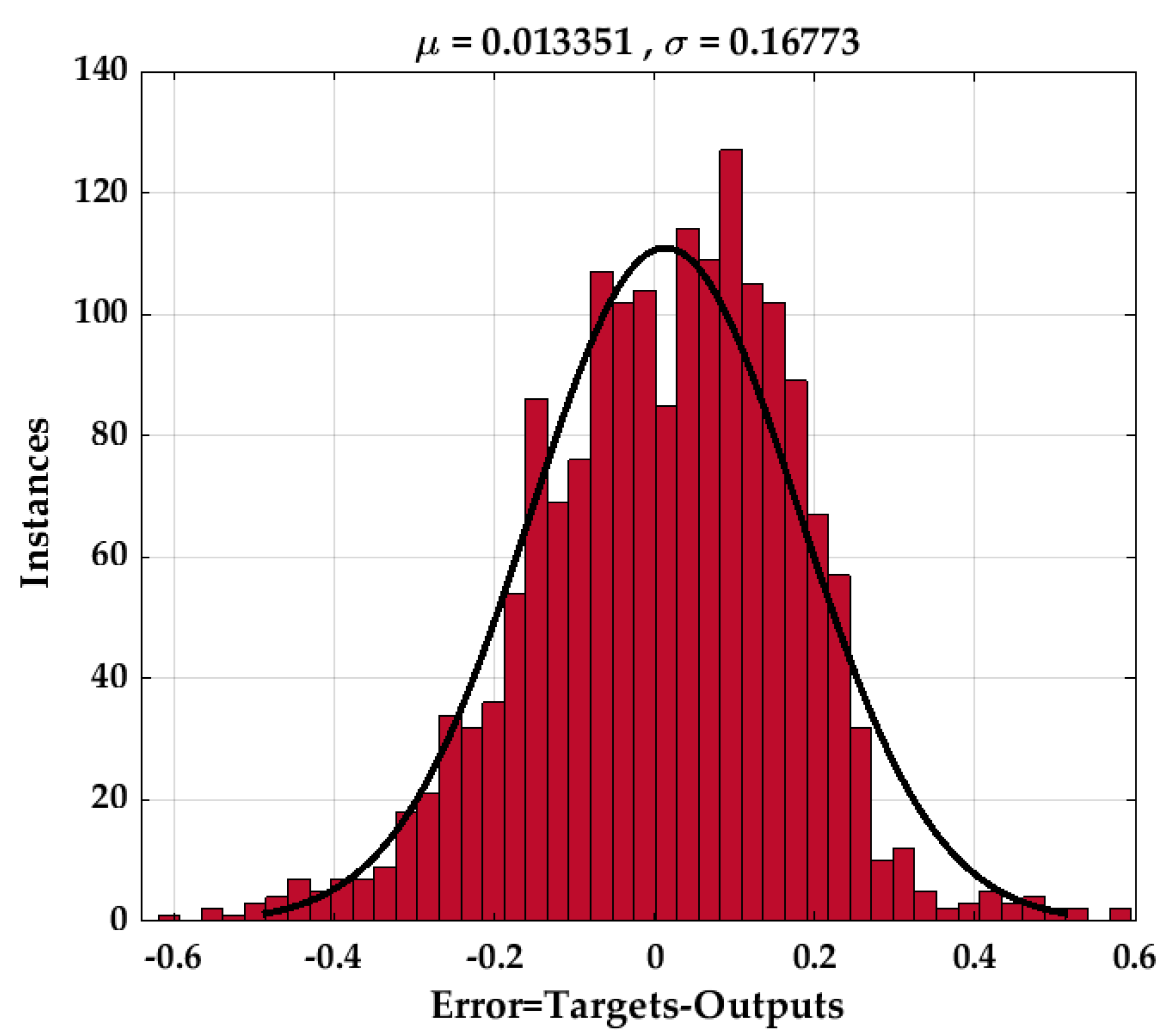Deep Learning-Assisted Short-Term Load Forecasting for Sustainable Management of Energy in Microgrid
Abstract
:1. Introduction
- Implementing a learning-based approach that, with its high skill, passes the training phase without problems such as missing data and overfitting;
- Forecasting microgrid load without considering meteorological data that are not available in remote areas;
- Modeling of microgrid load consumption for a short-term time horizon (one hour) based on different household and commercial consumption loads;
- Evaluating the performance of the Bi-LSTM technique in the training phase and the results of load forecasting with different performance evaluation indicators, as well as presenting a comparative approach to express the effectiveness of the suggested method.
2. Bidirectional Long Short-Term Memory (Bi-LSTM)
3. Case Study
4. Simulation Results
5. Conclusions
Author Contributions
Funding
Conflicts of Interest
References
- Ihsan, A.; Brear, M.J.; Jeppesen, M. Impact of operating uncertainty on the performance of distributed, hybrid, renewable power plants. Appl. Energy 2021, 282, 116256. [Google Scholar] [CrossRef]
- Caliano, M.; Bianco, N.; Graditi, G.; Mongibello, L. Design optimization and sensitivity analysis of a biomass-fired combined cooling, heating and power system with thermal energy storage systems. Energy Convers. Manag. 2017, 149, 631–645. [Google Scholar] [CrossRef]
- Akinyele, D.; Olabode, E.; Amole, A. Review of fuel cell technologies and applications for sustainable microgrid systems. Inventions 2020, 5, 42. [Google Scholar] [CrossRef]
- Sadeghian, O.; Moradzadeh, A.; Mohammadi-Ivatloo, B.; Abapour, M.; Marquez, F.P.G. Generation units maintenance in combined heat and power integrated systems using the mixed integer quadratic programming approach. Energies 2020, 13, 2840. [Google Scholar] [CrossRef]
- Khalid, H.; Shobole, A. Existing Developments in Adaptive Smart Grid Protection: A Review. Electric Power Syst. Res. 2021, 191, 106901. [Google Scholar] [CrossRef]
- Yan, B.; Di Somma, M.; Graditi, G.; Luh, P.B. Markovian-based stochastic operation optimization of multiple distributed energy systems with renewables in a local energy community. Electric Power Syst. Res. 2020, 186, 106364. [Google Scholar] [CrossRef]
- Ghorbani, S.; Unland, R.; Shokouhandeh, H.; Kowalczyk, R. An innovative stochastic multi-agent-based energy management approach for microgrids considering uncertainties. Inventions 2019, 4, 37. [Google Scholar] [CrossRef] [Green Version]
- Fayek, H.H.; Mohammadi-Ivatloo, B. Tidal Supplementary Control Schemes-Based Load Frequency Regulation of a Fully Sustainable Marine Microgrid. Inventions 2020, 5, 53. [Google Scholar] [CrossRef]
- Khan, M.; Khan, M.; Jiang, H.; Hashmi, K.; Shahid, M. An Improved Control Strategy for Three-Phase Power Inverters in Islanded AC Microgrids. Inventions 2018, 3, 47. [Google Scholar] [CrossRef] [Green Version]
- Lee, E.-K.; Shi, W.; Gadh, R.; Kim, W. Design and Implementation of a Microgrid Energy Management System. Sustainability 2016, 8, 1143. [Google Scholar] [CrossRef] [Green Version]
- Tayab, U.B.; Zia, A.; Yang, F.; Lu, J.; Kashif, M. Short-term load forecasting for microgrid energy management system using hybrid HHO-FNN model with best-basis stationary wavelet packet transform. Energy 2020, 203, 117857. [Google Scholar] [CrossRef]
- Zhang, Y.; Le, J.; Liao, X.; Zheng, F.; Li, Y. A novel combination forecasting model for wind power integrating least square support vector machine, deep belief network, singular spectrum analysis and locality-sensitive hashing. Energy 2019, 168, 558–572. [Google Scholar] [CrossRef]
- Liang, Y.; Niu, D.; Hong, W.C. Short term load forecasting based on feature extraction and improved general regression neural network model. Energy 2019, 166, 653–663. [Google Scholar] [CrossRef]
- Moradzadeh, A.; Zakeri, S.; Shoaran, M.; Mohammadi-Ivatloo, B.; Mohammadi, F. Short-term load forecasting of microgrid via hybrid support vector regression and long short-term memory algorithms. Sustainability 2020, 12, 7076. [Google Scholar] [CrossRef]
- Ferlito, S.; Adinolfi, G.; Graditi, G. Comparative analysis of data-driven methods online and offline trained to the forecasting of grid-connected photovoltaic plant production. Appl. Energy 2017, 205, 116–129. [Google Scholar] [CrossRef]
- Heydari, A.; Astiaso Garcia, D.; Keynia, F.; Bisegna, F.; De Santoli, L. A novel composite neural network based method for wind and solar power forecasting in microgrids. Appl. Energy 2019, 251, 113353. [Google Scholar] [CrossRef]
- Lopez-Garcia, T.B.; Coronado-Mendoza, A.; Domínguez-Navarro, J.A. Artificial neural networks in microgrids: A review. Eng. Appl. Artif. Intell. 2020, 95, 103894. [Google Scholar] [CrossRef]
- Che, J.; Wang, J. Short-term load forecasting using a kernel-based support vector regression combination model. Appl. Energy 2014, 132, 602–609. [Google Scholar] [CrossRef]
- Wen, L.; Zhou, K.; Yang, S.; Lu, X. Optimal load dispatch of community microgrid with deep learning based solar power and load forecasting. Energy 2019, 171, 1053–1065. [Google Scholar] [CrossRef]
- Selakov, A.; Cvijetinović, D.; Milović, L.; Mellon, S.; Bekut, D. Hybrid PSO-SVM method for short-term load forecasting during periods with significant temperature variations in city of Burbank. Appl. Soft Comput. J. 2014, 16, 80–88. [Google Scholar] [CrossRef]
- Sun, W.; Ye, M. Short-Term Load Forecasting Based on Wavelet Transform and Least Squares Support Vector Machine Optimized by Fruit Fly Optimization Algorithm. J. Electrical Comput. Eng. 2015, 2015, 862185. [Google Scholar] [CrossRef] [Green Version]
- Teng, W.; Cheng, H.; Ding, X.; Liu, Y.; Ma, Z.; Mu, H. DNN-based approach for fault detection in a direct drive wind turbine. IET Renew. Power Gener. 2018, 12, 1164–1171. [Google Scholar] [CrossRef]
- Zhang, S.; Zhang, S.; Wang, B.; Habetler, T.G. Deep Learning Algorithms for Bearing Fault Diagnostics—A Comprehensive Review. IEEE Access 2020, 8, 29857–29881. [Google Scholar] [CrossRef]
- Schmidhuber, J. Deep Learning in neural networks: An overview. Neural Netw. 2015, 61, 85–117. [Google Scholar] [PubMed] [Green Version]
- Moradzadeh, A.; Pourhossein, K. Short Circuit Location in Transformer Winding Using Deep Learning of Its Frequency Responses. In Proceedings of the 2019 International Aegean Conference on Electrical Machines and Power Electronics, ACEMP 2019 and 2019 International Conference on Optimization of Electrical and Electronic Equipment, OPTIM 2019, Istanbul, Turkey, 27–29 August 2019; IEEE: New York, NY, USA, 2019; pp. 268–273. [Google Scholar]
- Teimourzadeh, H.; Moradzadeh, A.; Shoaran, M.; Mohammadi-Ivatloo, B.; Razzaghi, R. High Impedance Single-Phase Faults Diagnosis in Transmission Lines via Deep Reinforcement Learning of Transfer Functions. IEEE Access 2021, 9, 15796–15809. [Google Scholar] [CrossRef]
- Yu, J.J.Q.; Hou, Y.; Li, V.O.K. Online False Data Injection Attack Detection With Wavelet Transform and Deep Neural Networks. IEEE Trans. Ind. Inform. 2018, 14, 3271–3280. [Google Scholar] [CrossRef]
- Wang, H.; Lei, Z.; Zhang, X.; Zhou, B.; Peng, J. A review of deep learning for renewable energy forecasting. Energy Convers. Manag. 2019, 198, 111799. [Google Scholar] [CrossRef]
- Kong, W.; Dong, Z.Y.; Wang, B.; Zhao, J.; Huang, J. A practical solution for non-intrusive type II load monitoring based on deep learning and post-processing. IEEE Trans. Smart Grid 2020, 11, 148–160. [Google Scholar] [CrossRef]
- Moradzadeh, A.; Mohammadi-Ivatloo, B.; Abapour, M.; Anvari-Moghaddam, A.; Gholami Farkoush, S.; Rhee, S.B. A practical solution based on convolutional neural network for non-intrusive load monitoring. J. Ambient Intell. Humaniz. Comput. 2021. [Google Scholar] [CrossRef]
- Ebrahim, A.F.; Mohammed, O.A. Pre-processing of energy demand disaggregation based data mining techniques for household load demand forecasting. Inventions 2018, 3, 45. [Google Scholar] [CrossRef] [Green Version]
- Shrestha, A.; Mahmood, A. Review of deep learning algorithms and architectures. IEEE Access 2019, 7, 53040–53065. [Google Scholar] [CrossRef]
- Hochreiter, S.; Schmidhuber, J. Long Short-Term Memory. Neural Comput. 1997, 9, 1735–1780. [Google Scholar] [CrossRef] [PubMed]
- Zakeri, S.; Geravanchizadeh, M. Supervised binaural source separation using auditory attention detection in realistic scenarios. Appl. Acoust. 2021, 175, 107826. [Google Scholar] [CrossRef]
- Bengio, Y.; Simard, P.; Frasconi, P. Learning long-term dependencies with gradient descent is difficult. IEEE Trans. Neural Netw. 1994, 5, 157–166. [Google Scholar] [CrossRef]
- Xie, W.; Wang, J.; Xing, C.; Guo, S.; Guo, M.; Zhu, L. Variational Autoencoder Bidirectional Long and Short-term Memory Neural Network Soft-sensor Model Based on Batch Training Strategy. IEEE Trans. Ind. Inform. 2020. [Google Scholar] [CrossRef]
- Moradzadeh, A.; Mansour-Saatloo, A.; Mohammadi-Ivatloo, B.; Anvari-Moghaddam, A. Performance evaluation of two machine learning techniques in heating and cooling loads forecasting of residential buildings. Appl. Sci. 2020, 10, 3829. [Google Scholar] [CrossRef]
- Mansour-Saatloo, A.; Moradzadeh, A.; Mohammadi-Ivatloo, B.; Ahmadian, A.; Elkamel, A. Machine learning based PEVs load extraction and analysis. Electronics 2020, 9, 1150. [Google Scholar] [CrossRef]
- Afrasiabi, M.; Mohammadi, M.; Rastegar, M.; Kargarian, A. Multi-agent microgrid energy management based on deep learning forecaster. Energy 2019, 186, 115873. [Google Scholar] [CrossRef]







| Input Variable | Figure 2a | Figure 2b | Figure 2c |
|---|---|---|---|
| NoH | 50 | 100 | 100 |
| HI households | 33% | 45% | 20% |
| MI households | 33% | 30% | 30% |
| LI households | 33% | 25% | 50% |
| Number of WP | 5 | 3 | 3 |
| Number of GM | 1 | 1 | 1 |
| Number of SS | 5 | 3 | 3 |
| Number of Schools | 1 | 3 | 2 |
| Number of Clinics | 1 | 3 | 3 |
| Number of SL | 10 | 15 | 12 |
| Table | R | MSE | RMSE |
|---|---|---|---|
| Bi-LSTM (Proposed) | 0.9934 | 0.1042 | 0.3243 |
| SVR [14] | 0.9770 | 0.5983 | 0.7735 |
| LSTM [14] | 0.9809 | 0.5133 | 0.7164 |
| SVR-LSTM [14] | 0.9901 | 0.1316 | 0.3627 |
| SVM [19] | - | - | 6.1910 |
| MLP [19] | - | - | 5.6540 |
| CNN-GRU [39] | - | - | 0.1617 |
| CNN-LSTM [39] | - | - | 0.2265 |
Publisher’s Note: MDPI stays neutral with regard to jurisdictional claims in published maps and institutional affiliations. |
© 2021 by the authors. Licensee MDPI, Basel, Switzerland. This article is an open access article distributed under the terms and conditions of the Creative Commons Attribution (CC BY) license (http://creativecommons.org/licenses/by/4.0/).
Share and Cite
Moradzadeh, A.; Moayyed, H.; Zakeri, S.; Mohammadi-Ivatloo, B.; Aguiar, A.P. Deep Learning-Assisted Short-Term Load Forecasting for Sustainable Management of Energy in Microgrid. Inventions 2021, 6, 15. https://doi.org/10.3390/inventions6010015
Moradzadeh A, Moayyed H, Zakeri S, Mohammadi-Ivatloo B, Aguiar AP. Deep Learning-Assisted Short-Term Load Forecasting for Sustainable Management of Energy in Microgrid. Inventions. 2021; 6(1):15. https://doi.org/10.3390/inventions6010015
Chicago/Turabian StyleMoradzadeh, Arash, Hamed Moayyed, Sahar Zakeri, Behnam Mohammadi-Ivatloo, and A. Pedro Aguiar. 2021. "Deep Learning-Assisted Short-Term Load Forecasting for Sustainable Management of Energy in Microgrid" Inventions 6, no. 1: 15. https://doi.org/10.3390/inventions6010015
APA StyleMoradzadeh, A., Moayyed, H., Zakeri, S., Mohammadi-Ivatloo, B., & Aguiar, A. P. (2021). Deep Learning-Assisted Short-Term Load Forecasting for Sustainable Management of Energy in Microgrid. Inventions, 6(1), 15. https://doi.org/10.3390/inventions6010015








